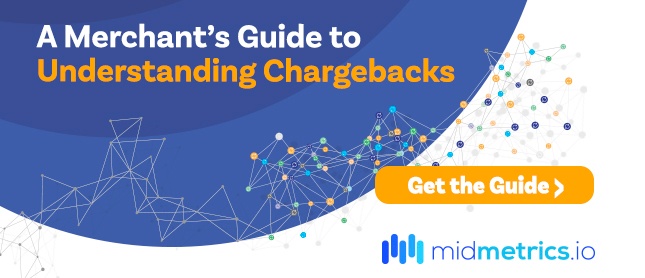
A Definitive Guide to Understanding Chargebacks
By Chris Alarie on Jan 26, 2021
Did you know that the average merchant loses around 5.4% of their annual revenue due to chargebacks? If that concerns you (and it certainly should), you need to make sure you understand how chargebacks work—and how to regain control.
If it feels like you’re dealing with more chargebacks every year, you’re not alone. This is an industry-wide problem, with some estimates suggesting the number of chargebacks is growing by 20% annually. It’s not just an issue because of the lost sales, either. You’ve also got to think about costs from marketing, manufacturing, and shipping—typically meaning financial losses of two to three times the sales price—and the potential damage to merchant accounts.
What can you do?
Merchants who want to protect their revenues, merchant accounts and reputations must first take steps to understand what chargebacks are, why they occur, and how the process works. We’ll cover all this and more.
What is a Chargeback?
A chargeback is essentially a refund that a consumer requests through their credit card provider or bank instead of directly through the merchant.
Government legislation originally introduced chargebacks to protect consumers when they buy from fraudulent sellers or don’t recognize a transaction, but customers can also file them when they’re unhappy with a product or service. For instance, if a shipment is late or a product was falsely advertised.
Unfortunately, not everyone sticks to the rules—some customers file chargebacks under unreasonable circumstances, or even use them as a money-making scheme. Since the burden of proof falls on the merchant to prove a chargeback is illegitimate, this can wreak havoc on business operations.
How do Chargebacks Work? [Chargeback Process]
We’ve already given a brief snapshot of how chargebacks work, but they get significantly more complicated when you take a more detailed look. The process involves many steps, from the chargeback issuer (customer) to their bank to the merchant and the merchant’s bank – and even an additional party if a resolution isn’t reached.
Here’s an overview:
-
A customer files a chargeback through their card provider or bank (also known as the issuer).
-
The customer’s bank returns the transaction to the retailer’s bank (also known as the acquirer).
-
The retailer’s bank resolves the chargeback or passes the charge on to the retailer through physical mail, email, fax, or online. Then, the retailer finds out the total chargeback amount, transaction amount, reason code, credit card number, chargeback case number, and any additional information.
-
The retailer decides whether to accept or reject the chargeback through representment (if they decide to fight against it, substantial evidence is needed, such as tracking numbers, terms & conditions, and invoices)
-
Assuming the merchant disputes the chargeback, the retailer’s bank then reviews the evidence. If it meets the necessary requirements, they forward the information to the customer’s bank.
-
The customer’s bank evaluates the evidence and decides whether to accept or reject the chargeback. This usually takes between 10-30 days.
-
Both the retailer and customer find out the final verdict. If either party disagrees, they can bring an impartial adjudicator into the process (also known as going into arbitration).
Types of Merchant Chargebacks
Chargebacks are often discussed as if they’re all one and the same, but there are actually various kinds, which differ depending on who made the chargeback and why. The main three types are friendly fraud, true fraud, and merchant error–we’ll discuss each one in further detail below.
Friendly Fraud
Friendly fraud is the most common type of chargeback, making up 60 – 90% of claims. Also known as chargeback fraud, these claims arise when a customer disputes a transaction even though they made it intentionally and the merchant charged the correct amount. The customer may file the chargeback for a range of reasons.
Unfortunately, most cases of friendly fraud come down to customers trying to cheat the system to obtain free products or services—but there are also more reasonable motives of friendly fraud. Key examples are disappointment with the good or service received, buyer's remorse or customers who couldn't cancel their purchase the legitimate way.
Family Fraud
Family fraud also falls under the category of friendly fraud. This happens when someone uses a card without the cardholder's knowledge or permission—it's usually by somebody close to them, like a partner or family member. After seeing a transaction they don't recognize on their statement, the cardholder files a chargeback.
True Fraud
True fraud encompasses disputes made after somebody other than the cardholder and their inner circle makes a transaction, all without the cardholder realizing. The culprit is usually a hacker or thief (this includes identity theft too). Around 10 – 15% of chargebacks are of this nature.
Merchant Error
Merchant error is somewhat different from the two categories above, because the fault lies at the merchant’s end. A retailer might charge too much, charge twice for the same transaction, charge the wrong person, or fail to issue a refund. These make up 15 — 35% of disputes, making them the second largest chargeback category.
Most Common Reasons for a Chargeback
Although most chargebacks fit into one of the three categories outlined above, these explanations alone fail to show the full range of reasons behind why people file disputes.
The list of chargeback reasons codes is enormous, and there are hundreds of motives and sub-motives for the disputes. Some customers are unhappy with their purchase due to slow delivery or poor quality, while others get charged for items they don’t recall buying. Then there are the people who use chargebacks as a way to get items for free.
Here are four of the most common explanations.
Poor Customer Service
Just as customers can be disappointed with a product or service, they can also be frustrated with the service they receive. In fact, up to 30% of chargebacks may be due to poor customer service.
This often happens after customers try and fail to follow official cancellation procedures—perhaps they sent multiple emails and never received a reply, or they spent hours on hold to a call center. Or maybe they simply thought the staff member they talked to was too rude and didn't treat them fairly, so they decided to file a dispute.
Fulfillment Issues
A closely related problem is fulfillment issues. Everything related to packing and delivering an item comes under this category, and they make up between 1-15% of chargebacks.
The most common fulfillment-related problems are late delivery, products damaged during the shipping process, and packages that never arrive. Sometimes, the selection of poor-quality items is also an issue.
Canceled Subscriptions
As an increasing number of businesses pivot toward a subscription model, problems related to subscription cancelations have caused an abundance of chargebacks.
This can be the merchant's fault if they fail to cancel the subscription or their cancellation process is too difficult to navigate, forcing desperate customers to resort to a chargeback instead.
However, there are also occasions when customers file disputes to receive their subscription for free.
Affiliate Fraud
The chargeback causes above all stem from problems between the merchant and the customer. Yet some transactions also involve a third party—affiliates (partners that market a product or service in exchange for commission).
By creating fraudulent transactions, affiliates can make money from merchants, which believe the transactions were legitimate and pay out. Although this eventually results in chargebacks, the affiliates will have already taken their cut, leaving merchants to foot the bill.
Of course, this is only something to concern merchants that take part in affiliate marketing. But since it’s said to account for 10–60% of chargebacks, it’s a significant problem.
What Credit Card Chargebacks Mean for Merchants
A customer can file a chargeback without submitting any proof that their stated reason for the dispute is valid (e.g., that a product is damaged).
The burden of proof falls on the merchant. As a result, chargeback fraud is relatively easy, and most retailers must commit serious time to handling their chargebacks. But there’s also a positive angle to this problem—merchants have the opportunity to reverse the disputed charge each time, however it still remains as a chargeback on the merchant’s account.
Let’s look at how this works for the two major types of transactions: card-present and card-not-present transactions.
Card-Present Merchants
When customers buy from retail merchants in-store, they use physical cards to pay. These are known as card-present (CP) transactions.
It was once possible to carry out fraudulent transactions by cloning cards, which was relatively straightforward when everyone used magnetic strip credit cards. However, it has become more difficult (but not impossible) thanks to the introduction of EMV chip-based cards.
To ensure liability for CP transactions doesn’t go to the acquirer (the merchant’s financial institution), merchants should use an EMV chip readable terminal for all EMV chip cards. This automatically makes the issuing bank (the cardholder’s financial institution) liable. If the merchant can’t use one of these machines, they will be liable for all chargebacks when there are disputes.
In the case of true fraud, merchants aren’t liable for chargebacks—but they are responsible for problems related to their service and/or product, like making merchant errors or providing poor-quality goods.
Card-Not-Present Merchants
Card-not-present (CNP) transactions include any purchases made over the internet, mail, or the phone. Unlike CP transactions, merchants have liability for all chargebacks (even true fraud) until they can prove they’re innocent.
However, retailers can shift liability to the issuing bank by using 3D Secure Technology, which makes them responsible for disputes that arise following 3D Secure verified transactions claimed to be fraudulent or unauthorized. Of course, the retailer will still be liable for disputes stemming from other causes, like poor customer service.
Chargeback Thresholds
To avoid facing serious difficulties, merchants must keep an eye on their chargeback threshold: The maximum number of chargebacks the merchant can face each month without being shut down for suspicious activities. This number differs between card networks.
Most card networks also have a maximum chargeback ratio, calculated as the total number of monthly chargebacks divided by the total number of transactions over the same period. For instance, issuing 10 chargebacks on 1,000 transactions in a month would result in a chargeback threshold of 1%.
If retailers exceed their chargeback ratios or thresholds, the card network will eventually shut their account down and leave them unable to open a new account. This is therefore one of the most important metrics to keep an eye on.
Visa
Visa has an early warning chargeback ratio of just 0.65% and a chargeback threshold of 75 chargebacks a month, making them the most stringent card network of the bunch.
When merchants reach these numbers, Visa will automatically enroll them in a pre-monitoring program, while exceeding 100 chargebacks a month or a 0.90% chargeback ratio leads to joining a Merchant Monitoring program.
MasterCard
MasterCard is somewhat more generous than Visa, with a chargeback threshold of 100 per month and a chargeback ratio of 1%. However, they deal with excessive chargebacks similarly.
Exceeding the initial metrics leads to a Chargeback Monitored Merchant program, while surpassing a 1.5% chargeback ratio or 100 chargebacks results in status as an Excessive Chargeback Merchant.
American Express
Unlike MasterCard and Visa, American Express assesses merchants more holistically, considering chargeback metrics alongside a wider range of risk factors. Still, going over 100 chargebacks and a 1% chargeback ratio will generally flag a retailer as risky.
Discover
Discover also doesn’t have any hard rules in place. But again, it’s best for merchants to stay within 100 monthly chargebacks and a 1% chargeback ratio.
Chargeback Fees: The True Cost of Your Chargebacks
Merchants are mostly concerned with chargebacks because they mean lost sales. This means that the credit card transaction amount is reversed, debiting the merchant and providing the credit back to the consumer. There is also the loss of the cost of the product or service provided. But another significant factor to consider are the fees involved.
Chargebacks result in various fees, including:
-
Chargeback fees – The chargeback itself leads to a bank penalty, which is usually between $15 and $40. Yet this is far from the only cost retailers face.
-
Transaction fees – Most payment processors charge a 3.5–4% fee for every transaction, which will be lost money in the case of a chargeback. This means serious losses on larger transactions.
-
Operational costs – Processing an order involves various steps, including picking, logistics, and transportation. Combined together, these costs can easily reach 20% of a merchant’s total revenue, all of which is lost after a chargeback.
-
Marketing and acquisition costs – Most retailers spend significant sums on their marketing efforts, making a dent in total revenue worth around 30–40%. That might sound like a lot, but businesses must cover sales and marketing staff, advertising campaigns, and more. Again, this becomes lost money after a chargeback.
To put this into context, let’s look at the fees that would result from a $100 purchase.
|
Transaction value |
$100 |
|
Transaction fee (4%) |
$4 |
|
Product costs (23%) |
$23 |
|
Marketing costs (35%) |
$35 |
|
Operational costs (20%) |
$20 |
|
Chargeback fee ($25) |
$25 |
|
TOTAL |
$207 |
Incredibly, a chargeback on a transaction worth $100 ends up resulting in a loss of $207—that's not an amount to shrug off.
Although facing a few losses is inevitable, merchants certainly shouldn’t be accepting every chargeback filed. Especially if they know they’ve delivered their product or service, as described, with promptness and good customer service. The first step to avoiding chargebacks and recovering these losses is staying on top of disputes and knowing how to fight back.
Merchant Chargeback Rights
Although the introduction of chargebacks was an important step in providing consumer rights, they’ve unfortunately ended up harming many honest merchants.
While consumers should be able to receive protection after falling victim to fraud, transaction errors, or corrupt/poor-quality merchants, retailers shouldn’t be left to foot the bill if their greatest mistake was doing business with consumers taking advantage of the system.
Fortunately, merchants can take steps to defend themselves.
Retailers have the right to representment, meaning they can fight against the chargeback dispute. This disincentivizes cardholders from filing chargebacks in the first place—especially if there’s an easier way for them to request a refund through the usual cancellation process.
However, prevention is a better cure. Most Issuers partner with third parties like Ethoca and Verifi to provide chargeback prevention services, such as chargeback alerts, which put an extra step in place before a dispute progresses to an official chargeback. Although there are fees for these services, they usually save merchants more money than they cost when used effectively, and they’re also an extra buffer against reaching chargeback thresholds.
The Right Partner for the Chargeback Fight
Fighting chargebacks takes time and effort. You’re required to present compelling evidence to show that the original transaction was legitimate. Maintaining, organizing, and locating the documents you need to fight a claim can be difficult. Having the assistance of knowledgeable experts can give you a tremendous advantage in succeeding at chargeback representation. They have knowledge of the various chargeback types, reason codes, and the arguments and evidence that can be used to dispute them.
The right chargeback company isn’t just going to fight your chargebacks successfully and win back your revenue. They’ll also give you the prevention tools you need, as well as the knowledge and insights that tell you how to put to those tools to best use. Most importantly, the right chargeback company will never leave you in the dark about where your chargeback rate stands and how effectively their chargeback prevention and recovery services are performing.
MidMetrics provides all the essentials of chargeback representment and prevention, along with a full suite of our own proprietary chargeback management tools, which include Management Dashboards, In-Depth Analytics Tools, and On-Demand Reports. This gives you a single powerful platform you can use to manage your chargebacks and protect your merchant accounts, all for one price.
It would be possible to get similar tools and services a la carte from multiple providers, but it would probably cost you a lot more—and it’d be entirely up to you to get all these different components to play nicely together. MidMetrics is expertly designed to be easy to use, easy to integrate with the systems you already have, and still powerful enough to take on the most challenging chargeback scenarios.
Want to see MidMetrics in action? Book a demo with one of our chargeback specialists today.
For merchants, understanding chargebacks is essential to in order to fight them correctly and protect merchant accounts and revenue. We cover all this and more in our guide, A Merchant's Guide to Understanding Chargebacks.



